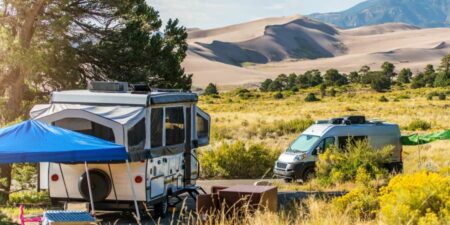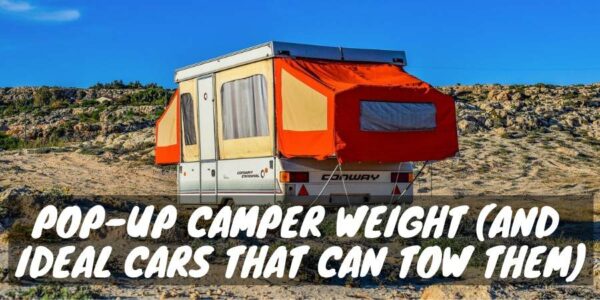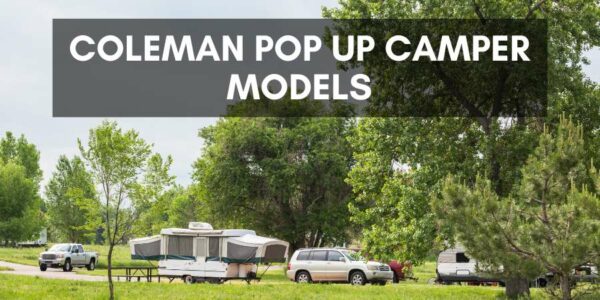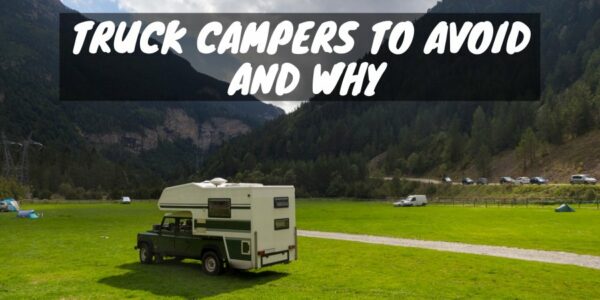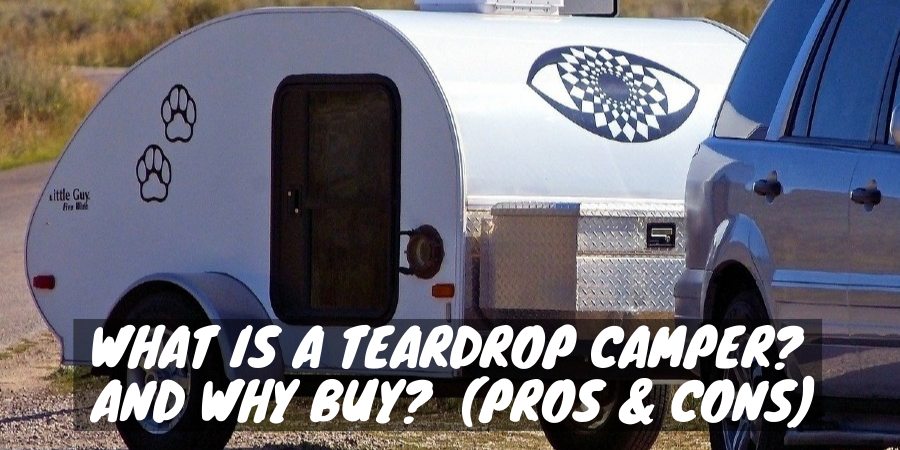Why are pop-up campers so popular? They are a low-cost entry point into the RV lifestyle, with enough room for big families with minivans or family-friendly SUVs. In other words, you get the space and amenities of a travel trailer. Yet you also receive the price and weight of a teardrop.
Come with us as we explore the many pros and cons of pop-up campers. We’ll show you how old they really are, what features you can expect in them regardless of brand, and many other points of interest you’ll need if you’re considering buying one of these RVs.
Key Points
- Pop-up trailers are budget-friendly and expand to travel trailer sizes
- The pop-up camper is ideal for families
- Full-size cars and minivans can pull pop-up campers
- Hard-shell pop-ups have the same insulation as travel trailers
- Pop-up campers are one of the easiest RVs to store
What Is a Pop-Up Camper?
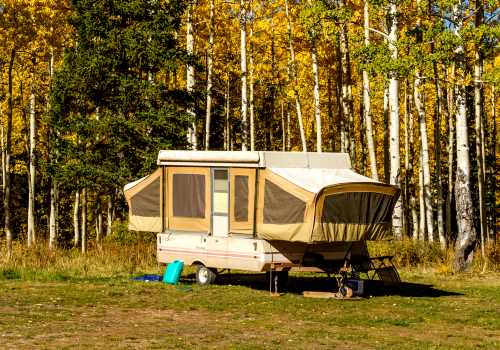
Pop-up campers are smaller towable camping trailers. Half of the exterior shell collapses into itself for easy towing and storage. The main trailer body has a hard shell of fiberglass composite panels or variations of the material. There’s enough headroom for people to stand straight and walk around when the RV is open. The chassis sits on a single axle and mounts to a ball hitch.
The features and amenities in a pop-up camper are comparable to travel trailers. You’ll find kitchenettes, dinettes, storage, and plenty of sleeping space. Many models have climate control, and some include wet baths.
Many pop-up campers are towable by full-size cars, minivans, and small SUVs. They are budget, family, and storage-friendly. People who are curious about the RV lifestyle find pop-ups a great way to start the adventure.
History of Pop-Up Campers
There are two relevant origins of pop-up campers. The original conception of a mobile trailer people live in was perfected by the Romanichal (or Romany) and Irish Travelers as early as the 16th Century. These two separate cultures lived a nomadic life throughout Europe with everything they needed in a horse-drawn covered wagon.
During the western expansion of the United States, settlers would similarly use covered wagons to stake their claim and start their new life in the land of “Milk and Honey.” With the invention of rudimentary suspension, the journey was still rough, and the horsepower could be moody.
Click here to see the Popular Mechanics tent camper image.
The more applicable origin are the trailers pulled by the automobiles of the 1910s and forward. Once Henry Ford’s assembly line made cars affordable, it wasn’t long before companies like Shattuck Trailers and Praire Schooner hung their shingle and began mass production of tent trailers.
These early pop-up campers were essentially canvas tents set up inside a trailer’s frame instead of the ground. As Americans began touring around the country, this became a great alternative to tent camping. Once the Great Depression hit, many of the RV manufacturers closed their doors since the public had more immediate concerns.

Those RV companies that did survive would retool to join in on the Second World War effort. After the war, new technologies gave birth to travel trailers with a similar shape to Spam containers. Veterans and their families loved the “Canned Ham” era coaches with home-like features and minimal setup requirements.
It wouldn’t be until the late 1960s and early 1970s that the tent camper would come back to the RV world’s main stage. David Rowe, the creator of Four-Wheel Campers, designed a roof lift system for truck campers. His idea was to lower the roof when traveling to make the camper more aerodynamic and easier to drive under low bridges.
Rowe’s pop-up technology is the basis for truck campers today — use a soft-shell fabric on the upper end of the sidewalls to allow the roof to rise and collapse. Travel trailer companies took his designs one step further to create a family-friendly camper with a pull-out bed on either end, a top that doubled the height, and was light enough to be pulled by the average family station wagon.
For more information on pop-up campers’ history, or if you want to see some vintage pop-up campers in mint condition, check out the RV Hall of Fame in Elkhart, Indiana. If you’re interested in more stories about them, a significant amount of legacy RVers started with pop-up campers either owning one or spending family vacations in their parent’s pop-up.
Soft-Shell Pop-Up Campers
Of the two main types of pop-up camper shells, the soft side is the most popular and widely recognized. RV manufacturers have transitioned from the “old school” canvas to a specialized vinyl ideal for pop-up campers. Pop-ups are vulnerable to moisture problems, so they do their best to design flaps and other components to protect the coach.
Windows are double or triple-layered, depending on the manufacturer. One layer is tinted for privacy and has ultraviolet protection. The second layer is a screen that lets the breeze come in, not mosquitos or other flying insects. If there’s a third layer, it’ll be a clear plastic that allows the natural light in but keeps the interior air contained.
Kitchen counters, dinette backs, and any other features that exist above the travel trailer hull fold down for travel purposes. Check out the video above to see how soft-shell pop-ups are set up.
Hard Shell Pop-Up Campers
From 1965 to the late 1980s, Vesley Manufacturing of Lapeer, Michigan, made the Apache Camper. Instead of canvas, the foldable shell used aluminum plates. The Apache opened into the same T-shape that soft-shells form. Due to outdoor temperature and other factors, the aluminum would warp, making setup difficult.
Today’s hard shells are also known as A-frames. When you set up a hard-shell pop-up, the roof forms the outer lines of the letter “A.” For extra space, some models have side dormers that flatten out the top and increase headspace on the sides of the pop-up.
A-frames don’t have the pull-out beds that soft-shells come with, but the folding walls come insulated with rigid foam materials. The insulated walls better contain the pop-up camper interior temperatures and make early/late season camping more comfortable.
Soft-shell pop-up trailers can sleep up to 8 people, whereas hard-sided pop-up campers will max out at 4. You’ll find that the travel trailer hulls can be longer to maximize interior space.
Teardrop Pop-Up Campers
Some independent RV companies are blending the pop-up benefits with teardrop sizing. One of the best examples is the Sylvan Sport Go. This multi-purpose teardrop has a lot of utility functions and a removable pop-up component, so you can use the trailer by itself.
When you expand this pop-up teardrop camper, the vinyl tent sleeps up to four people and has an adjustable table. The company has companion kitchenette accessories that fit under the awning to complete the camping experience.
Micro Motorcycle Pop-Up Campers
Motorcycle pop-up camper trailers have been around for decades. When expanded, beds come in either full or queen-size. Some accommodate additional features like climate control, flooring, and seating to give riders and their companion a comfortable camping experience.
Pop-Up Campervan/Class B Motorhomes
There are a few Class B motorhomes that have expandable roofs. Check out our feature article on campervans to learn more about them. We will mention that these roof pop-ups have loft space that acts as a second bedroom for kids and teenagers for our current purposes.
Pop-Up Truck Campers/Soft-Side Truck Campers
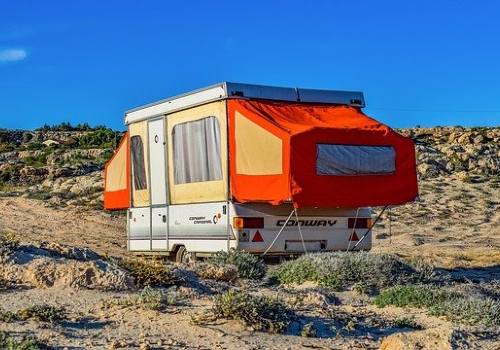
We talked about David Rowe’s expandable truck camper previously. We continue that discussion of soft-shell truck campers in our article dedicated to that category. The pop-up feature on these campers allows you to lower the roof up to 12 inches to make the coach more aerodynamic for the road.
Hybrid Trailers
Hybrid travel trailers are expandables, but they aren’t pop-ups. The only thing that opens is the bed spaces, while the kitchen and living room maintain their shape in the travel trailer space. In some situations, you can use a hybrid trailer without opening the bed spaces. We’ll discuss this more in our category feature.
Pop-Up Camper Specification Ranges
| Closed Lengths | 7- 24 feet |
| Open Lengths | 12.8- 31 feet |
| Sleep | 2- 8 people |
| Dry Weight (empty weight of the RV) | 300- 3721 pounds |
| Gross Vehicle Weight Rating (a.k.a. GVWR- the most weight the RV can safely hold) | 400- 5,000 pounds |
| Price | $2,750- $40,000 |
Ideal Tow Vehicles
Matching your tow vehicle to a pop-up camper is less of an issue compared to other heavier categories. You’ll still need a vehicle that has a tow package pre-installed, but you won’t need a V8 gas-guzzler to tow it.
Your RV dealer will help you with finding the right pop-up for your vehicle. Your owner’s manual will tell you the specific towing capacity for the vehicle you own. If you’re still unclear, your RV or auto dealer can advise you.
As you look at the different expandable campers, look at the Gross Vehicle Weight Rating (GVWR) as your weight guideline. This measurement tells you how much weight the RV can safely hold. The dry weight only tells you how heavy the pop-up is when it’s empty.
During your vacation, you’ll have all of your camping gear and personal items stored inside. You’ll also have you and your family inside the tow vehicle. You don’t want to overtax your vehicle’s towing limit. To learn more about the various weight factors and essentials, check out our article about the numbers you need to know for safe towing.
| MODEL | TOW CAPACITY |
| BMW X3 | 4,400 lbs |
| Chevrolet Equinox | 3,500 lbs |
| Chrysler Pacifica | 3,600 lbs |
| Ford Explorer | 5,600 lbs |
| Honda Goldwing 1800 | 5,500 lbs |
| GMC Yukon | 8,400 lbs |
| Jeep Grand Cherokee | 7,200 lbs |
| Nissan Pathfinder | 6,000 lbs |
| Toyota Highlander | 5,000 lbs |
| Volvo XC60 | 5,291 lbs |
Popular RV Manufacturers of Pop-Up Campers
The pop-up camper allowed many of today’s big names to be what they are today. Names like Starcraft, Jayco, and Coleman were highly sought after. Today, of the big four (Forest River Inc., REV Group, Thor Ind., and Winnebago Ind.), only Forest River subsidiaries continue to produce products in the Pop-up category.
The category’s independent producers hybridize pop-ups by crossing them into the teardrop sector or using the hard shell versions to lean into the small travel trailer marketplace.
| BRAND | MANUFACTURER |
| ALiner | Independent |
| Chalet | Independent |
| Coachmen Clipper | Forest River Inc. |
| Coachmen Viking | Forest River Inc. |
| Flagstaff | Forest River Inc. |
| North Coast | Independent |
| Opus | Independent |
| Rockwood | Forest River Inc. |
| Sylvan Sport | Independent |
| Trailmanor | Independent |
| Turtleback Trailers | Independent |
Pop-Up Camper Standard Features Expectations
The level of features inside a pop-up exists between an RV with beds and storage to virtually everything you’d find in a travel trailer. Here are the features you can expect to see in most pop-up camper trailers when you walk through an RV show or at your local RV dealer.
Kitchen
Pop-ups will come with a single basin sink and propane dual burner stovetop. Only units will not include the stove. Dorm-sized refrigerators that run on electricity and propane are common too. Mid-grade hard shells and above will find a place for a built-in microwave.
Living Room
Bigger soft-shell expandables have a gaucho sofa that jackknifes into a bed. Otherwise, the dinette is the main multi-purpose sitting area. The four-seater dinette folds into a bed that can sleep up to 2 people.
Bedroom
Soft-shell pop-ups have slide-out beds on the back and front of the RV. The beds can be measured from full to king-size. Some models have both beds measured equally, while others have one bigger than the other. The longer of the two is generally the front bed over the hitch.
Flagstaff and Rockwood have an optional mattress with interior heating coils. The bed plugs into the inside 110v outlet so sleepers can stay warm on cooler nights. It comes in both hard and soft-shell units. Hard-shell A-frames have beds similar to travel trailers. They lift for strategic storage underneath. You’ll also find models with dual twin beds. Twin bed travel trailer floor plans are making a comeback due to their advantages. It’s easier to get out of bed, has more storage, and has a bridge piece that converts them into a king.
Bathroom
At first, only luxury pop-up campers came with bathrooms. The cassette toilet sits inside a cabinet that opens up, and a shower curtain pulls around for privacy. As it became more popular and technology innovated, pop-up camper bathrooms have evolved into wet baths with holding tanks.
People can take a hot shower, brush their teeth, and take care of their needs. Forest River even developed models that replace the shower curtain with movable walls to make the bathroom experience less confining.
Storage Tanks
Pop-up campers have holding tanks. If the pop-up camper has a sink, it has a freshwater and grey waste tank. Those that come with bathrooms will either come with five-gallon cassette tanks or have installed black waste tanks.
The average holding tank size for pop-up campers will range between 10-20 gallons. For perspective, this gives 2 to 3 people enough water to cook, drink, and wash dishes for a few days. If you plan on dry camping in a pop-up camper, make sure you stay close to a dump station and water source since you’re going to be cycling your tanks often.
Storage
Pop-ups primarily have floor-level cabinetry. You may find some strategic storage under the dinette benches as well. RV manufacturers add independent waterproof storage bins at the front of the RV frame for exterior storage.
Want to Connect With a Community of Over 1,078 RV Enthusiasts?
Opus Camper is the exception. Their kitchen appliances pull out on the coach’s exterior, giving you the most interior space possible to sit and sleep. A family of four or more won’t find all of the storage space they want in this category. There are many pop-up camper storage ideas you can find online via social media and other websites. Repurposing things like hanging fabric shoe trees on the back of a cabinet door becomes pouch space for toiletries, cleaning supplies, or other essentials.
Power and Propane
Pop-up campers come with removable propane bottles. The dual (or single) tanks, cooktop, and water heater fuel the RV refrigerator while traveling. Since they’re removable, many stores have an exchange system where you turn in your empty bottle, and you can grab a new filled one.
Many pop-ups now come with house batteries mounted on the hitch. Pop-ups don’t have inverters that transfer the DC power to AC, but the battery will let you turn on the interior lights, the exterior utility light, and some essentials. If you’re looking to go off-grid, using a solar panel system will work, but don’t expect to mount more than one panel on the roof. Pop-up campers don’t have the roof reinforcements like travel trailers do. Pop-up camper A/C units are smaller not only because there’s less interior space but also because the roof can handle a certain amount of weight. Ground solar is a better option.
Technology
Media technology in pop-up trailers is limited. You will find a small multimedia radio system in the mid-through luxury models. Cabinets will have a flat surface to place a TV with its stand.
The best technological advances are the safety features and the lift system. Most pop-ups still use a cabling system to lift the roof. If one of the steel cables breaks, the other three still hold. Manufacturers now have one-piece braces that you place over the lift arms as safety catches. The lift system is either electronic or positioned on the hitch. Back in the 1970s and 80s, the lift crank was under the coach. Cranking them up required kneeling and taxing your back. Today’s pop-ups position the crank in a position that’s less taxing on the body.
Climate Control
Basic pop-up trailers won’t come with climate control features. A/C units and furnaces are optional features in bigger pop-up campers. Pop-ups are used during the RV season, so air conditioners are more common. RV dealers will order their units with A/Cs since the component is so popular.
Great Examples of Pop-Up Campers
| The Smallest Pop-Up Camper | Sylvan Sport Go |
| The Best Hardsided Pop-up Camper | Trailmanor 3124 |
| The Best Luxury Pop-Up Camper | Forest River Flagstaff HW29SC |
| The Best Off-Road Pop-Up Camper | Opus Camper OP4 |
| The Best Motorcycle Pop-Up Camper Trailer | Time Out Trailers Time Out Deluxe |
| The Best Pop-Up Camper With a Bathroom | Forest River Rockwood Tent HW296 |
Matching to Your Camping Style
Positive Pop-Up Camper Reviews and Ratings
A significant portion of second or third-generation RVers today have plenty of campfire stories about their childhood in a pop-up camper. Often, people who start in the #TentLife find themselves in a pop-up camper because they still want to have that tent-like feel. It’s relatively inexpensive to buy a coach in this category, which is ready for camper amenities.
They’ll tell you about how their parent’s Colman camper pop-up was a part of the most incredible family memories they have. Others may tell you about how they got the best sleep in their parent’s Starcraft pop-up camper as the sound of rain hitting the canvas lulled them to sleep.
Pop-up camper designers create their masterpieces with weekenders in mind. They know that the target audience will have the RV stored for long periods and take it out one or two weekends a month. Those looking for a coach that can handle anything longer than two weeks should consider travel trailers.
The average length limit in national parks is 30 feet. Some of the lesser-known parks have limits as low as 20 feet. This makes most pop-ups ideal. The best way to make a reservation with national parks is to call them directly. Some parks will not let you expand over that limit. While your trailer hull fits that length limit, the park rangers may take issue once you pull out your beds.
Pop-up campers are the easiest RVs to store. They fit in home garages, RV indoor storage units, RV outdoor storage parking spaces, and many RV self-storage places in your area. In the city, suburb, or rural area, there’s always a spot for a pop-up.
Is A Pop-Up Camper Worth It?
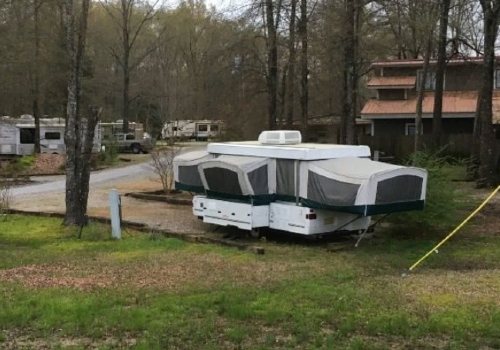
We mentioned earlier how pop-up campers are not ideal for boondocking since they don’t have the storage capacity to sustain you for an extended period. Public and private campgrounds will give you the best camping experience.
The biggest issue with pop-up campers is maintenance. Pop-ups require the most preventive maintenance of all the categories. Since they have many essential moving parts and the soft shells are fabric, if there’s a way for moisture to find a way in, it will.
Water will create an environment for mold, mildew, and fungus to grow. It’ll also find a chip in the metal pieces’ sealant armor to begin the oxidation process. If you ever have to break down your pop-up in the rain, make sure you set it up when you get home to let it dry out to avoid these problems.
Other issues that come up are the axles. They require a yearly greasing. RV manufacturers now install a tube to inject fresh grease into the ball bearings to prevent them from drying out. If you go through a preventive checklist 2-3 times a year (at the beginning of the RV season, right before you store it for the winter, and maybe halfway into the season), you can avoid almost all of the problems.
The Next Step
Now that you have a good perspective, your next step should be to take a few out for a weekend to gain first-hand knowledge. Peer-to-peer rental companies like Outdoorsy or RVshare help you find pop-up campers in your area that rent out. The best part is you’re renting from real people, not a corporate fleet.
We recommend trying out different brands and configurations to maximize the experience. Your first one can be from a specific company and have a particular floorplan. The next one should be from a different RV manufacturer and have a different floor plan. Do this as much as you want to get a real feel of the category.
While you’re renting, you can continue with RV Troop by reading through our unbiased articles on the latest pop-ups on the market. We’ll walk you through each series and discuss what industry experts and individual owners say about them.
When you’re ready to buy, you’ll have first-hand knowledge from renting and our critical reviews to help you make a confident purchase. AS a new RVer with your first coach, stick around to learn all of the best camping tips and tricks to make your RV experience the best possible.
Welcome to the RV lifestyle!
"Man cannot discover new oceans unless he has the courage to lose sight of the shore."
-- Andre Gide


